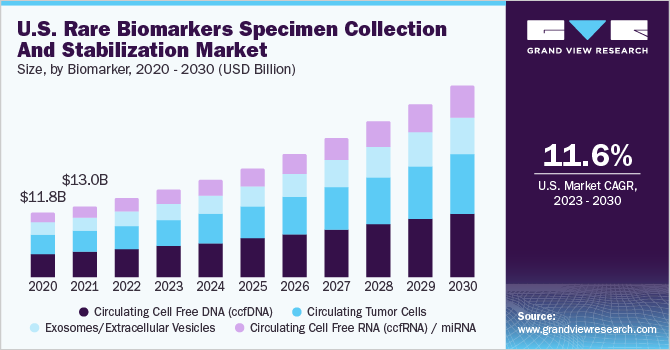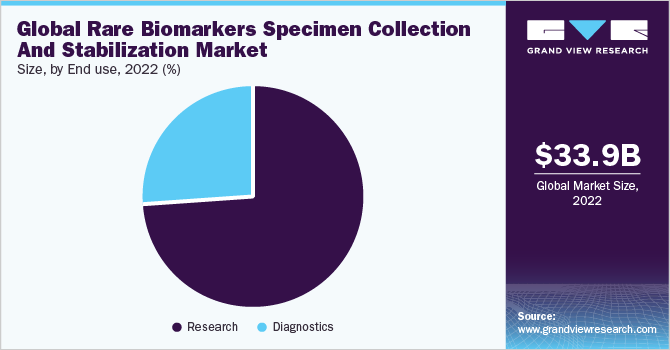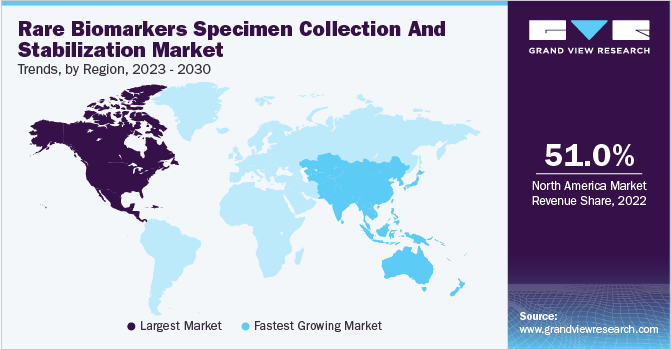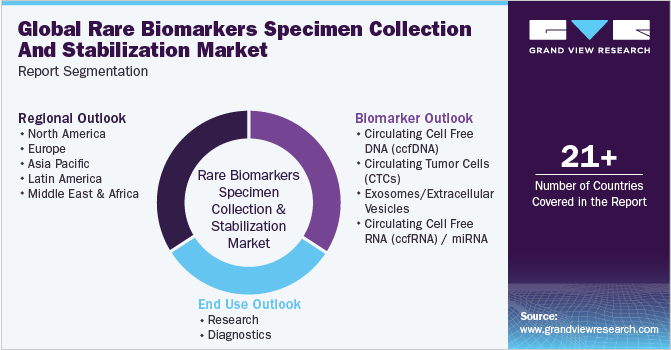- Home
- »
- Biotechnology
- »
-
Rare Biomarkers Specimen Collection And Stabilization Market Report, 2030GVR Report cover
![Rare Biomarkers Specimen Collection And Stabilization Market Size, Share & Trends Report]()
Rare Biomarkers Specimen Collection And Stabilization Market Size, Share & Trends Analysis Report By Biomarker, By End-use (Research, Diagnostics), By Region, And Segment Forecasts, 2023 - 2030
- Report ID: GVR-4-68038-459-8
- Number of Report Pages: 209
- Format: PDF, Horizon Databook
- Historical Range: 2018 - 2021
- Forecast Period: 2023 - 2030
- Industry: Healthcare
Report Overview
The global rare biomarkers specimen collection and stabilization market size was valued at USD 33.9 billion in 2022 and is expected to grow at a compound annual growth rate (CAGR) of 12.2% from 2023 to 2030. A substantial increase in research studies to depict the role of circulating biomarkers in disease management is driving the market. Factors such as increasing preference for a non-invasive mode of disease treatment and increasing demand for personalized medicine have impacted the revenue growth of the market to a major extent.

Over the past few years, the number of research studies in this area has increased exponentially. The number of scientific papers on these rare biomarker specimen collection and stabilization methods indicates the expanding interest of healthcare entities in this market for rare biomarkers specimen collection and stabilization. Moreover, increasing evidence on the effective role of rare biomarkers in disease management has driven investments toward clinical applications. In October 2022, Thermo Fisher Scientific Inc. announced an investment of USD 59 billion to expand its laboratory operation in Kentucky. The expansion aims to provide clients with high-quality central lab and biomarker services for clinical research programs.
The emergence of liquid biopsy for cancer management has played a pivotal role in shaping rare biomarker specimen collection and stabilization tube market dynamics. Companies engaged in conducting liquid biopsies or are developing/planning to enter this space are recognized as one of the primary growth factors of the market for rare biomarkers specimen collection and stabilization within clinical settings. Currently, liquid biopsy is limited to patients with advanced, metastatic cancer who cannot undergo a tissue biopsy. Primarily liquid biopsy analysis focuses on three types of biomarkers: cell-free nucleic acids, circulating tumor cells, and exosomes.
Regulatory challenges and limited reimbursement are key constraints for the clinical adoption of these tests. However, an increase in data on the clinical utility of these assays is anticipated to drive the uptake. The clinical space is not limited to liquid biopsy. Companies are engaged in developing and commercializing ccfDNA-based NIPT and have also attracted notable capital inflow from investors to advance this segment regarding test volume and revenue.
In addition, despite significant attempts in this relatively new field of research, challenges such as complications in characterization and ineffective separation protocols for biomarker specimen collection and stabilization have also held back commercial revenue growth. Researchers and other key stakeholders are engaged in expanding the implementation of these rare biomarkers by providing granular insights into their roles in disease progression and therapeutic applications.
Biomarker Insights
The circulating cell-free DNA (ccfDNA) segment accounted for the largest revenue share of 37.4% in 2022. Growing preference for non-invasive cancer diagnostics has spurred investment in the commercialization of liquid biopsy blood specimen collection and stabilization tubes. This further aids in revenue growth for cfDNA, exosome, and CTCs. The growth of cfDNA is also benefited by increasing the adoption of NIPT in detecting chromosomal anomalies in the fetus. In May 2022, Tethis S.p.A announced the launch of See.d, a universal blood sample preparation device for liquid biopsy analysis. The device can prepare blood samples entirely, automatically, and uniformly at the blood collection point.
Increasing investment in exploring the utility of CTCs in diagnosis, prognosis, and treatment monitoring has provided lucrative growth opportunities to players involved in developing marketing kits and collection and stabilization solutions for CTC isolation. Various companies in this segment include Miltenyi Biotec, QIAGEN, Creatv MicroTech, Veridex, Creative-Bioarray, and Genetix. These companies offer products for both research as well as clinical use.
Out of all the populations of Extracellular Vesicles (EVs), exosomes are the most commonly studied. A substantial number of assays have been developed for profiling and enrichment of EVs; however, lack of standardization has posed a threat to the development in this segment in the past few years. With emerging applications of these molecules as the third target of liquid biopsies, key developers of rare biomarker specimen collection and stabilization products have begun investing in developing a portfolio for this segment.
The circulating cell-free RNA (ccfRNA) / miRNA segment is expected to grow at the fastest CAGR of 13.1% during the forecast period. This trend is primarily besides that these vesicles are present in a substantial amount in plasma. These molecules are more abundant than CTCs or ccfDNA. The Circulating Cell-Free RNA (ccfRNA) segment is estimated to account for the lowest revenue share in the market. This is owing to the fact that the implementation of this rare biomarker is limited within the research settings. Circulating miRNA has organ tissue specificity. Thus, the investigation of the circulating miRNA has gained much attention within research settings, contributing to revenue generation in this segment.
End Use Insights
The research segment accounted for the largest revenue share of 73.9% in 2022. The segment's dominance is attributed to several ongoing research studies on rare biomarker implementation. Interest in rare biomarkers, such as exosomes, RNA, DNA, and CTCs, has risen exponentially in the past few years owing to their exclusive functions as intercellular messengers, their therapeutic potential in disease diagnostics, abilities to alter recipient cell bioactivities and emerging applications in targeted drug delivery. In April 2023, QIAGEN launched of QIAseq Targeted cfDNA Ultra Panels. These panels are designed to allow scientists researching cancer and other diseases to create libraries suitable for next-generation sequencing (NGS) from cell-free DNA (cfDNA) liquid biopsies in less than eight hours.

The number of research studies pertaining to the collection and stabilization of rare biomarkers has increased significantly, thus providing opportunities for researchers to manipulate the composition, properties, and cell interactions of these rare biomarkers to advance therapeutic applications further. In addition, improvements in the methods used to isolate and purify rare biomarkers aid research studies by minimizing the number of errors. Thus, incorporating efficient and reliable isolation methods in basic research sets the foundation for therapeutic applications of rare biomarkers.
The diagnostics segment is estimated to grow at the fastest CAGR of 12.3% over the forecast period. These rare biomarkers currently have major applications within research settings. However, Circulating Cell-Free DNA (ccfDNA), Circulating Tumor Cells (CTCs), and exosomes are being increasingly explored for being used in various diagnostic modalities. In recent years, cfDNA and exosomes have been among the rapidly evolving minimally invasive diagnostic markers used for early detection and therapy response prediction in solid tumors. In May 2023, LabCorp announced the launch of LabCorp Plasma Focus, a liquid biopsy test that enables tailored therapy selection for individuals with advanced or metastatic solid cancers.
Regional Insights
North America dominated the market and accounted for the largest revenue share of 51.0% in 2022. Key factors contributing to the large revenue share of this regional market for rare biomarkers specimen collection and stabilization include a wide client base coupled with a substantial number of FDA-approved products. Moreover, the number of approved rare biomarker isolation kits for both clinical and research use is anticipated to increase with expanding liquid biopsy and assisted reproductive technology space in the region.

Blood specimen collection and stabilization tube with a patented preservative enables the stabilization of cell-free RNA in plasma. It avoids the release of non-target background RNA from a blood specimen. Blood specimen collection and stabilization tubes minimize the need for immediate plasma preparation and facilitate convenient sample isolation, transport, and storage. The geographic distribution of products varies according to the vendor. For instance, STRECK, INC.’s Cell-Free RNA BCT is licensed for sale in the EU and Canada.
Asia Pacific is expected to grow at the fastest CAGR of 13.3% during the forecast period. The ongoing conferences and seminars for raising awareness about the role of rare biomarkers in disease management among the Asian population, including patients, healthcare personnel, and research entities, are anticipated to spur the uptake of rare biomarker isolation solutions. In August 2023, Clinical Chemistry Conference will be held in Bangkok, Thailand. The conference is aimed to provide laboratory professionals with a thorough understanding of biomarkers as clinical and diagnostic tools for clinical research.
Key Companies & Market Share Insights
The introduction of novel assays, such as liquid biopsy assays, and the emergence of microfluidic-based biomarker separation technologies have resulted in an increase in the overall market competition in recent years. With new product launches and expanding applications, this competition in the market is anticipated to intensify in the coming years. Companies are making strategic agreements to gain a competitive edge in exosome isolation. In March 2023, nRichDX partnered with OraSure Technologies, Inc., to jointly market their products for scientists working on liquid biopsy applications using first-void urine samples. Additionally, first-void urine is abundant in biomarkers that can be used for molecular analysis in cases like sexually transmitted diseases, the human papillomavirus, and early-stage cancer.
Furthermore, in April 2019, Macrogen and Exosome Plus signed a supply contract under which Macrogen would be the exclusive buyer of the exosome isolation kits developed by the latter company. Exosome Plus would supply its Exo2D to Macrogen for one year, and Macrogen would sell the isolation kits to third parties. In addition, diagnostic developers and genomic service providers that have entered the space are making focused attempts to establish a strong presence in the market and eventually gain a high market share. In addition, Abacus dx announced RNA Complete BCT, the latest addition to Streck's blood collection tube lineup. This innovative tube ensures the preservation of cell-free RNA concentration during blood draws while minimizing the release of extracellular vesicles like exosomes from blood cells. With RNA Complete BCT, these crucial analytical targets can be maintained for up to seven days at room temperature, providing a convenient sample collection, transport, and storage solution.
Furthermore, biopharmaceutical companies, such as Roche and Amgen, have collaborated with companies offering liquid biopsy for the development of companion diagnostics and accelerate the personalized medicine approach. The entry of biopharma players in the market for rare biomarkers specimen collection and stabilization is anticipated to spur competition among various key stakeholders, including diagnostics developers and service providers. The following are some of the major participants in the global rare biomarkers specimen collection and stabilization market:
-
QIAGEN
-
Charles River Laboratories
-
F. Hoffmann-La Roche Ltd
-
Thermofischer Scientific Inc.
-
Eurofins Scientific
-
PerkinElmer Inc.
-
Bio-Rad Laboratories, Inc.
-
Agilent Technologies, Inc
-
Merck KGaA
-
Siemens Healthcare GmbH
Rare Biomarkers Specimen Collection And Stabilization Market Report Scope
Report Attribute
Details
Market size value in 2023
USD 37.68 billion
Revenue forecast in 2030
USD 84.18 billion
Growth rate
CAGR of 12.2% from 2023 to 2030
Base year for estimation
2022
Historical data
2018 - 2021
Forecast period
2023 - 2030
Report updated
September 2023
Quantitative units
Revenue in USD billion and CAGR from 2023 to 2030
Report coverage
Revenue forecast, company ranking, competitive landscape, growth factors, and trends
Segments covered
Biomarker, end use, region
Regional scope
North America; Europe; Asia Pacific; Latin America; and MEA
Country scope
U.S.; Canada; UK; Germany; France; Italy; Spain; Denmark; Sweden; Norway; Japan; China; India; Australia; South Korea; Thailand; Brazil; Mexico; Argentina; Saudi Arabia; South Africa;UAE; Kuwait
Key companies profiled
QIAGEN; Charles River Laboratories; F. Hoffmann-La Roche Ltd; Thermofischer Scientific Inc.; Eurofins Scientific; PerkinElmer Inc.; Bio-Rad Laboratories, Inc.; Agilent Technologies, Inc; Merck KGaA; Siemens Healthcare GmbH
Customization scope
Free report customization (equivalent up to 8 analyst’s working days) with purchase. Addition or alteration to country, regional & segment scope
Pricing and purchase options
Avail customized purchase options to meet your exact research needs. Explore purchase options
Global Rare Biomarkers Specimen Collection And Stabilization Market Report Segmentation
This report forecasts revenue growth at global, regional, and country levels and provides an analysis of the latest industry trends in each of the sub-segments from 2018 to 2030. For this study, Grand View Research has segmented the global rare biomarkers specimen collection and stabilizationmarket on the basis of biomarker, end use, and region:

-
Biomarker Outlook (Revenue in USD Billion, 2018 - 2030)
-
Circulating Cell Free DNA (ccfDNA)
-
Circulating Tumor Cells (CTCs)
-
Exosomes/Extracellular Vesicles
-
By Product
-
Isolation Kits & Reagents
-
Blood Collection Tubes
-
Systems
-
-
By Specimen Type
-
Serum/Plasma
-
Others
-
-
By Nucleic Acid & Other Biomolecules
-
RNA
-
DNA
-
Others
-
-
By Application
-
NIPT
-
Oncology
-
Research
-
Diagnostics
-
Screening
-
Treatment Monitoring
-
-
-
Transcriptomics
-
Pharmacogenomics
-
Transplant Rejection
-
Population Screening
-
Cardiovascular Diseases
-
Other Applications
-
-
-
Circulating Cell Free RNA (ccfRNA) / miRNA
-
By Product
-
Isolation Kits & Reagents
-
Blood Collection Tubes
-
-
By Application
-
NIPT
-
Oncology
-
Research
-
Diagnostics
-
-
Transcriptomics
-
Pharmacogenomics
-
Transplant Rejection
-
Population Screening
-
Cardiovascular Diseases
-
Other Applications
-
-
-
-
End Use Outlook (Revenue in USD Billion, 2018 - 2030)
-
Research
-
Research Labs/CROs
-
Academic Institutes
-
-
Diagnostics
-
Laboratories
-
Hospitals
-
Prenatal Clinics
-
-
-
Regional Outlook (Revenue in USD Billion, 2018 - 2030)
-
North America
-
U.S.
-
Canada
-
-
Europe
-
UK
-
Germany
-
France
-
Italy
-
Spain
-
Denmark
-
Sweden
-
Norway
-
-
Asia Pacific
-
Japan
-
China
-
India
-
Australia
-
Thailand
-
South Korea
-
-
Latin America
-
Brazil
-
Mexico
-
Argentina
-
-
Middle East and Africa
-
South Africa
-
Saudi Arabia
-
UAE
-
Kuwait
-
-
Frequently Asked Questions About This Report
b. The global rare biomarkers specimen collection and stabilization market size was estimated at USD 33.9 billion in 2022 and is expected to reach USD 37.68 billion in 2023.
b. The global rare biomarkers specimen collection and stabilization market is expected to grow at a compound annual growth rate of 12.2% from 2023 to 2030 to reach USD 84.18 billion by 2030.
b. Circulating Cell-Free DNA (ccfDNA) dominated the rare biomarkers specimen collection and stabilization market with a share of 37.4% in 2022. This is attributable to the presence of a relatively high number of ccfDNA isolation solutions for clinical use.
b. Some key players operating in the rare biomarkers specimen collection and stabilization market include Agena Bioscience, ANGLE plc., AS ONE INTERNATIONAL, BioChain Institute, Inc., Biolidics Limited, Biomatrica, Bio-Techne Corporation, and OraSure Technologies Inc.
b. Key factors that are driving the market growth include popularity of NIPT services, increasing preference for liquid biopsy, and increasing investment for exploring the utility of CTCs in diagnosis, prognosis, and treatment monitoring.
Share this report with your colleague or friend.
![gvr icn]()
NEED A CUSTOM REPORT?
We can customize every report - free of charge - including purchasing stand-alone sections or country-level reports, as well as offer affordable discounts for start-ups & universities. Contact us now
![Certified Icon]()
We are GDPR and CCPA compliant! Your transaction & personal information is safe and secure. For more details, please read our privacy policy.
We are committed towards customer satisfaction, and quality service.
"The quality of research they have done for us has been excellent."





